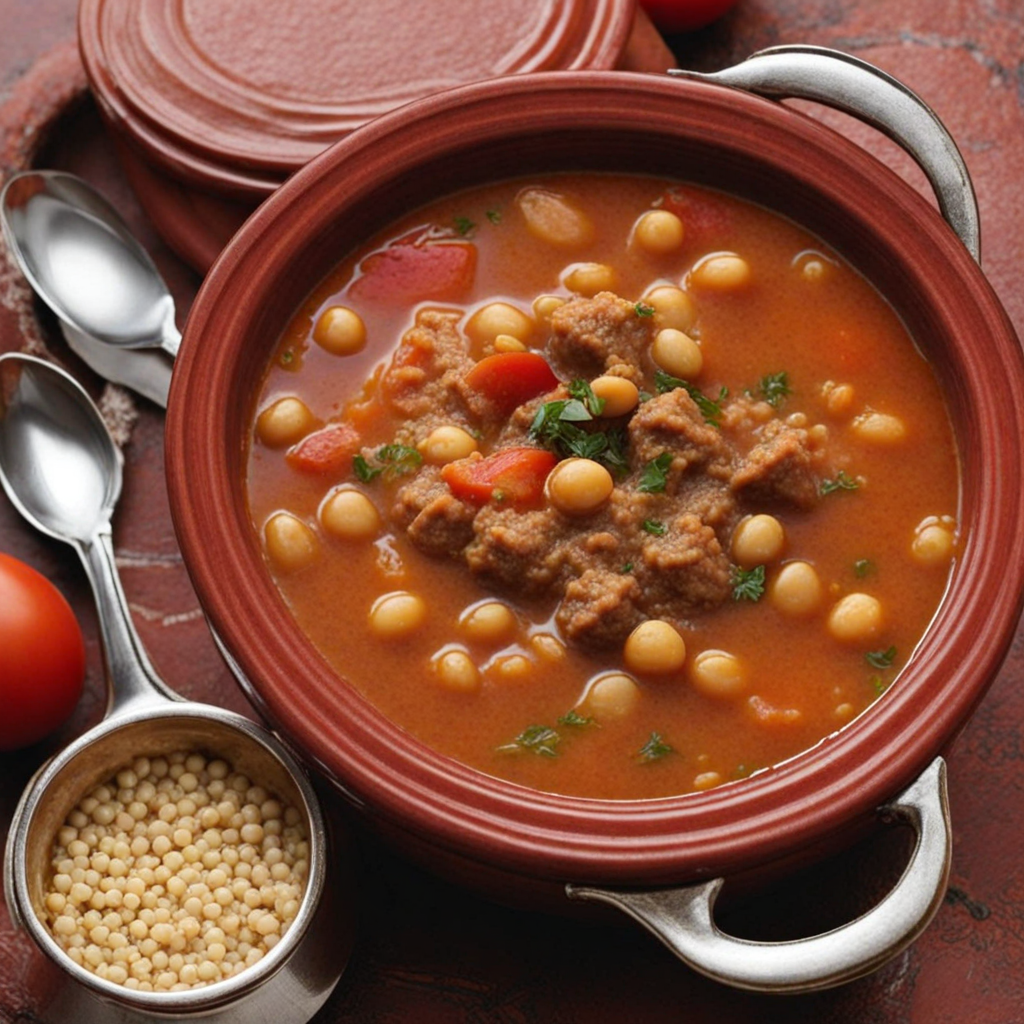Assida
Assida is a traditional Tunisian dish that beautifully showcases the country’s rich culinary heritage. This dish is primarily made from semolina flour, which is cooked with water until it reaches a smooth, pudding-like consistency. The process involves stirring continuously to achieve the perfect texture, resulting in a dish that is both creamy and slightly sticky. The semolina takes on a subtle sweetness, enhanced by the addition of sugar or honey, making Assida a delightful treat that can be enjoyed at any time, whether as a dessert or a comforting snack. One of the most fascinating aspects of Assida is its versatility. While the basic recipe remains the same, it can be tailored to suit individual tastes and occasions. Often, it is served with a drizzle of olive oil or melted butter, adding a rich, savory dimension. In some variations, nuts, dried fruits, or spices like cinnamon and anise are incorporated, introducing an aromatic element that elevates the dish. This adaptability not only reflects the diverse flavors of Tunisian cuisine but also invites creativity in the kitchen for those eager to experiment. Assida is more than just a dish; it is a cultural experience that brings people together. Traditionally, it is served in a communal bowl, and diners often enjoy it using their hands, fostering a sense of connection and sharing. The dish is especially popular during festivities and gatherings, symbolizing hospitality and warmth. For anyone looking to explore new flavors, Assida offers a unique taste of Tunisia, combining simplicity with depth, and is sure to leave a lasting impression on your palate.
How It Became This Dish
The History of عصيدة: A Culinary Gem of Tunisia #### Origins of عصيدة عصيدة, pronounced "Asida," is a traditional Tunisian dish that has roots deeply embedded in the country's rich culinary tapestry. Its origins can be traced back to the early Arab influences in North Africa, particularly during the Islamic expansion in the 7th and 8th centuries. The term "Asida" itself is derived from the Arabic word "asida," which means "to bind" or "to unite," alluding to the dish's characteristic texture that binds ingredients into a cohesive, comforting form. Historically, Asida was made from simple ingredients that were widely accessible to the rural populace, particularly wheat flour, water, and salt. As the dish evolved, variations emerged, incorporating different ingredients depending on local customs, resources, and seasonal availability. The use of wheat flour reflects the agricultural practices of the region, where grains have been a staple for centuries. #### Cultural Significance Asida holds a special place in Tunisian culture and is often associated with communal gatherings, celebrations, and rituals. It is not merely a dish; it embodies the spirit of sharing and hospitality that is integral to Tunisian society. Traditionally served during religious festivities, including Eid al-Fitr and Eid al-Adha, Asida symbolizes unity and abundance. In many Tunisian homes, the preparation of Asida is a family affair. The process of making Asida – mixing, kneading, and cooking the dough – often brings family members together, reinforcing bonds and encouraging the passing down of culinary traditions from one generation to the next. The act of enjoying Asida is often communal, served on a large platter where everyone can partake, embodying the values of togetherness and generosity. #### Development Over Time Asida has evolved significantly over the centuries, adapting to the influences of various cultures that have traversed Tunisia, including the Berbers, Romans, Ottomans, and the French. Each of these cultures left an indelible mark on Tunisian cuisine, and Asida is no exception. 1. Early Variations: Initially, Asida was a simple porridge-like dish, primarily consumed by the working class as a filling, nutritious meal. It was often served with a drizzle of olive oil or honey, offering a balance of savory and sweet flavors. The addition of spices would have been minimal, reflecting the austere nature of early Tunisian cooking. 2. The Ottoman Era: With the arrival of the Ottomans in the 16th century, the culinary landscape of Tunisia began to flourish. Asida started to incorporate more complex flavors and ingredients. The Ottomans introduced spices such as cinnamon and nutmeg, enhancing the dish's profile. Additionally, the use of nuts and dried fruits became more common, elevating Asida into a dish suited for feasts and special occasions. 3. French Colonial Influence: The French colonial period in the 19th and early 20th centuries brought about further transformations in Tunisian cuisine, including Asida. The introduction of new cooking techniques and ingredients, such as dairy products and chocolate, led to innovative variations of the dish. Some Tunisian families began preparing a richer, creamier version of Asida, often served with a sweet sauce or custard. 4. Modern Interpretations: Today, Asida is celebrated in various forms across Tunisia. While traditional recipes remain cherished, contemporary chefs and home cooks have embraced creativity, experimenting with flavors and presentations. Some modern variations include adding fruit purees, flavored syrups, and even fusion elements, where Asida is paired with ingredients from other culinary traditions. #### Ingredients and Preparation The traditional preparation of Asida involves a few basic steps. The core ingredients typically include: - Flour: While wheat flour is the most common, some variations use semolina or a combination of flours. - Water and Salt: Essential for creating the dough. - Garnishes: Depending on the region and occasion, garnishes can include honey, olive oil, nuts (such as almonds or walnuts), and spices. To prepare Asida, the flour is mixed with water and salt to form a dough, which is then kneaded until smooth. The dough is cooked in a pot, often stirred continuously to achieve a thick, cohesive texture. Once cooked, Asida is typically shaped into a mound and served warm, accompanied by sweet or savory toppings. #### Contemporary Relevance In today's globalized world, Asida continues to be a beloved dish among Tunisians and is gaining recognition beyond national borders. The rise of interest in traditional and authentic cuisines has led to a resurgence in the popularity of dishes like Asida, which are seen as emblematic of Tunisia's cultural heritage. Culinary festivals and events celebrating Tunisian cuisine often showcase Asida, allowing chefs to demonstrate their interpretations of this timeless dish. The increasing accessibility of international ingredients has also led to new hybrids and adaptations, making Asida a versatile canvas for culinary creativity. Moreover, with the growing awareness of the importance of preserving food heritage, Asida is often highlighted in discussions about sustainable food practices. Its simplicity and reliance on local ingredients resonate with contemporary movements advocating for farm-to-table dining and the celebration of local produce. #### Conclusion Asida is not just a dish; it is a narrative of Tunisia's history, culture, and resilience. From its humble beginnings as a staple for the working class to its status as a symbol of celebration and community, Asida has woven itself into the fabric of Tunisian life. As it continues to evolve and adapt, the spirit of Asida remains a testament to the enduring power of food to connect people, tell stories, and preserve traditions. Whether enjoyed in a bustling market or a family home, Asida remains a culinary gem that captures the essence of Tunisia's rich cultural heritage.
You may like
Discover local flavors from Tunisia







